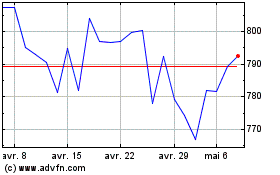American Luxury Is Finally in Vogue -- Heard on the Street
25 Mai 2021 - 12:01PM
Dow Jones News
By Carol Ryan
European luxury brands tend to be better investments than
American ones, but this year may be an exception.
Shares in Tapestry, the New York-listed holding company for
labels including Coach and Kate Spade, are up 40% since the start
of the year, while Michael Kors-owner Capri has gained 27%. That
puts both stocks ahead of big European peers such as Hermès, LVMH
Moët Hennessy Louis Vuitton and Gucci-owner Kering.
One reason is that the U.S. brands reported better than expected
sales in their latest quarterly numbers, thanks in part to strong
demand for designer clothing and handbags in China. Their
e-commerce businesses are growing quickly: Tapestry's online sales
have doubled in a year and now comprise almost 30% of turnover.
The two companies have also managed their inventory levels
better lately, allowing them to sell more products at full price
and increase their gross margins. And their valuations had more
ground to make up after investors fled to the safest luxury stocks
such as Birkin handbag maker Hermès throughout 2020.
American luxury names have sometimes outperformed in the past,
but it isn't the norm. In terms of share-price gains, Capri has
beaten Hermès and LVMH in just three of the last nine calendar
years. The U.S. stocks have also been far more volatile, after
several years of overexpansion damaged perceptions of their brands
among consumers. While Europe's top couturiers have overexpanded at
times too, on the whole they are better at managing their brand
image. The continuity provided by anchor shareholders such as
LVMH's Bernard Arnault, the world's second-richest man, may
help.
Tapestry and Capri's store locations could work to their
advantage in 2021, though. Both businesses still make around
three-fifths of revenue in their domestic U.S. markets, where a
strong economic rebound is boosting demand for high-end fashion.
Lower exposure to Europe, where even the most global French and
Italian brands still have a big presence, is a plus in the short
term. Luxury sales in traditional hot spots such as Paris, London
and Milan are expected to be sluggish until tourism recovers.
Designer stores in Europe rely on overseas visitors for around half
of their sales, Jefferies estimates.
The American stocks also look comparatively cheap at around 14
times projected earnings, below the 10-year average. Most European
names command at least double that multiple and are finding
investors increasingly hard to impress. On the day that Hermès
reported blistering first-quarter sales growth of 44%, its shares
inched up just 2%. The brand's Paris-listed stock currently fetches
56 times expected earnings.
Less exclusive brands and lower profit margins mean that U.S.
luxury names will never be as highly prized as their European
rivals -- either by shoppers or shareholders. But this year's broad
economic recovery gives the more affordable end of the sector the
chance to regain some lost ground.
Write to Carol Ryan at carol.ryan@wsj.com
(END) Dow Jones Newswires
May 25, 2021 05:55 ET (09:55 GMT)
Copyright (c) 2021 Dow Jones & Company, Inc.
Lvmh Moet Hennessy Louis... (EU:MC)
Graphique Historique de l'Action
De Mar 2024 à Avr 2024

Lvmh Moet Hennessy Louis... (EU:MC)
Graphique Historique de l'Action
De Avr 2023 à Avr 2024
